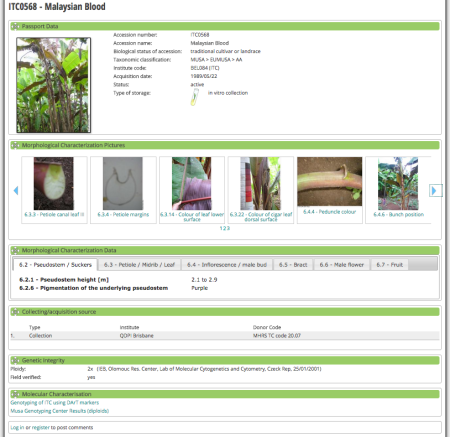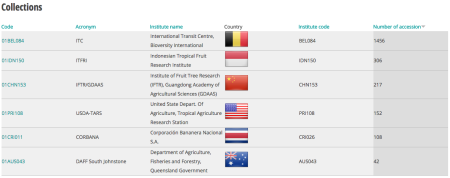Great to see a new version of the Musa Germplasm Information System (MGIS) released. The URL is unchanged. The key improvements are listed as follows (slightly edited):
1. All information on a single accession can be viewed in one page
2. Taxonomic content of each collection is summarized graphically.
3. Easier data filtering and export functions.
4. Users can share comments on any accession.
5. Accessions can be requested online via the Musa Online Requesting system (MORS) with a modified interface.
I particularly like the ability to comment, though you do have to register for that. The data cover 2,281 accessions from six genebanks around the world, 1 including 1,456 in the International Transit Centre (ITC) managed by Bioversity International in Belgium:
The ITC data are also in Genesys, which shows 1,529 accessions rather than 1,456. I assume MGIS is the more up to date, but I’m unclear why there should be a difference. 2
You can search among the 2,281 accessions on name or number; or by filtering by any combination of genebank, species, subspecies, genome group (AAB, say), subgroup (Cavendish, say), country of origin, ploidy, whether there’s a photo, whether it’s been included in a molecular study, and availability. Searching is pretty fast.
Each accession gets a nice page summarizing all the pertinent information.

That information can include morphological characterization data, and illustrations, as you can see above, but I could not find a way of searching the database based on a particular descriptor or combination of descriptors. You get a map when collecting locality is known, but you can’t map multiple accessions, as far as I could see. You’d have to do that in Genesys, I guess.
If you want to download data, you have to cut and paste accession numbers into a form on another page, and then you get a CSV or XLS. It didn’t look to me like you could export either morphological characterization data or molecular data. I have to say I was disappointed by the whole export thing.
So, some good things, some not so good things in this new version of MGIS. I’ll be keeping an eye on it for further developments. And continue playing with it, of course. Maybe I missed something.

Dear Luigi,
Thank you for this blog post. We appreciated your positive comments on this new release of the MGIS.
The version is not only a new user interface but it is also a new database structure. MGIS Data are now recorded into a CHADO schema, which is widely used in the genomics community. The user interface is developed through the Drupal Content Management System using a specific module called Tripal to access the CHADO database. This migration was motivated by the need to link to genotyping and genomics studies and also to record data from evaluation trials in multiple environments. This is actually a recurrent need that has been pointed by DivSeek for instance.
We also wanted to facilitate feedback from users and there are required to register because we target users that really care about banana germplasm and not to deal with various spam messages.
With regards to data export, this is true that morphological data cannot be downloaded yet but it will be possible in the coming releases. The original idea was to empower users who want to export all data for a list of accessions at once.
Regarding the USDA collection based in Mayaguez, Puerto Rico, we will correct the FAO CODE in order to be compliant with Genesys, in particular since MGIS is a data provider of Genesys. Then, for the discrepancy of accessions count, this is due to the fact that we now make visible only alive accessions while we provided to Genesys also with lost and eliminated accessions some month ago. It will be fixed as well for consistencies reasons.
We plan to release each quarter an improved version of MGIS web site. In this framework, your comments will be taken into account for the next releases (perhaps not the planned one in April but the one in July).
Thanks again for your feedback and we invite anyone to spur on us to deliver better and more comprehensive Musa Germplasm Information System.
Max Ruas
Bioversity International